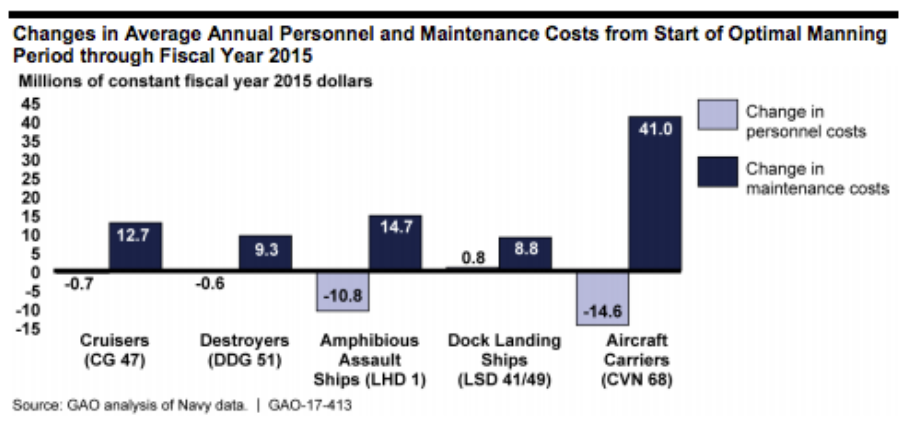The following is the May 18, 2017 GAO Report, NAVY FORCE STRUCTURE: Actions Needed to Ensure Proper Size and Composition of Ship Crews
From the report:
What GAO Found
Total ship operating and support costs—which include personnel and
maintenance costs—and maintenance backlogs increased during the optimal
manning period (2003–2012) and have continued to increase for most ship
classes since the initiative ended. Since the implementation of optimal manning,
the Navy reduced crew sizes, which decreased the associated personnel costs
for most ship classes, even as crews were partially restored. However, increased
maintenance costs offset the reductions in personnel costs, as shown below.
Navy officials attributed maintenance cost increases to reduced crews, longer
deployments, and other factors. GAO’s analysis did not isolate the relative
effects of reduced crews from these other factors. Maintenance backlogs also
increased during the optimal manning period and have continued to grow.
The Navy’s process to determine manpower requirements—the number and skill
mix of sailors needed for its ships—does not fully account for all ship workload.
The Navy continues to use an outdated standard workweek that may overstate
the amount of sailor time available for productive work. Although the Navy has
updated some of its manpower factors, its instruction does not require
reassessing factors to ensure they remain valid or require measuring workload
while ships are in port. Current and analytically based manpower requirements
are essential to ensuring that crews can maintain readiness and prevent
overwork that can affect safety, morale, and retention. Until the Navy makes
needed changes to its factors and instruction used in determining manpower
requirements, its ships may not have the right number and skill mix of sailors to
maintain readiness and prevent overworking its sailors.
Moving forward, the Navy will likely face manning challenges as it seeks to
increase the size of its fleet. The fleet is projected to grow from its current 274
ships to as many as 355 ships, but the Navy has not determined how many
personnel will need to be added to man those ships. In addition, as the Navy has
gained experience operating its new ship classes, their crew sizes have grown
and may continue to do so. Without updating its manpower factors and
requirements and identifying the personnel cost implications of fleet size
increases, the Navy cannot articulate its resource needs to decision makers.






